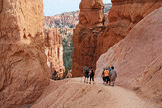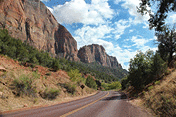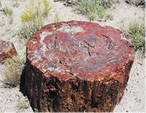Return to 2nd Quarter 2019 articles.

Driving through the West, Tom and I cringe at its dryness. Endless sand tufted with grass. Dust devils form whirling dervishes on flat land dotted with isolated stony mountains.

So why do we feel like we're underwater?
It's easy to picture ourselves on the sandy bottom of a vast sea, with islands formed by those mountaintops. Maybe it is easy because 300 million years ago, that is exactly how it was.
Earth was a completely different place eons ago. Our truck would have been underwater. There were no continents except one huge landmass called Pangaea. Then like an amoeba, Pangaea divided. Her daughters migrated, some rising, some sinking, until the earth assumed its modern form. Happily for us, the American West rose.

The Colorado Plateau, containing many of our National Parks, rose repeatedly. As I climb up a trail in the Grand Canyon, I have to stop and catch my breath — not surprising at 6,000 feet! The clear air rings with the panorama stretched out below. As the Colorado River sculpted its way through the land, it revealed deposits left by those ancient seas in the form of horizontal stripes in all colors. Folding of Earth's crust ensured that not all the peaks look the same. Watching over this kaleidoscope is the indigo high-desert sky. The thin air is not the only thing taking my breath away!

Bryce Canyon is even higher. Walking along the rim at 9,000 feet, weappreciate the benches every 25 yards. Sharing our perch are ponderosa pines clutching the rock with arthritic roots. As we gaze into the heart of the earth, eagles circle in search of prey some 2,000 feet below them. We sit about 1,000 feet above the birds. Although this place reminds us of the Grand Canyon, it lacks the gentler slopes we saw there. Why? At 9,000 feet, the mercury dives below freezing 200 times a year. Water flows straight down, and as it freezes, it chips vertical slabs from the rock. The resulting formations are called hoodoos and remind me of a crowd of football fans standing to watch their team score.

Zion Canyon offers the opposite perspective. A superb tram system carries us through the emerald oasis that forms the canyon floor. What a peaceful change from high-desert dryness! The landscape reminded Mormon settlers of a temple, and they named the place Zion. The Indians simply called it Straight-Up Land. We like their name better. Golden sandstone cliffs reach confidently toward the turquoise sky.
How does sand become stone? Pressure jams the grains together while rainwater leaches minerals that form cement. The same process clogs our pipes back home.
No western trip is complete without dinosaurs, so we go on the hunt. Every hunter knows if you want to find a critter, you find its food source. Dinosaurs are no different, so we head to the Petrified Forest. Here we see a record of life 225 million years ago.

Back then, this child of Pangaea had not wandered far from the equator yet. It was hot, humid, and green. Fossils show ferns, fish, and yes, dinosaurs. Stone logs the size of redwoods lie on the ground. In ages past, fallen trees were buried under layers of earth whose minerals leached into the wood. As the wood decayed, the stone remained. Different minerals left a confection of colors. If it is too hot to enjoy the logs, the dinosaur museum is air-conditioned.

Here is a little travel advice. First, the sun at 6,000 feet is three times as intense as it is where I live. Cover up and drink twice the water you think you need. Second, the traffic jams are legendary. For instance, one has to drive through a mile-long tunnel to get to Zion. This tunnel was opened in 1930 and features a broad, two-lane highway — for Model Ts. Today's motor coaches have to drive single file through the middle. Make your reservations early and be prepared to take your time.
The National Parks of the American West offer an experience unavailable anywhere else. Furthermore, they belong to us. Add them to your bucket list and do not wait too long.
Picture credits:
Photos in this article: Roland Earnst
Diagram of the earth © designua. Image from BigStock.com.
